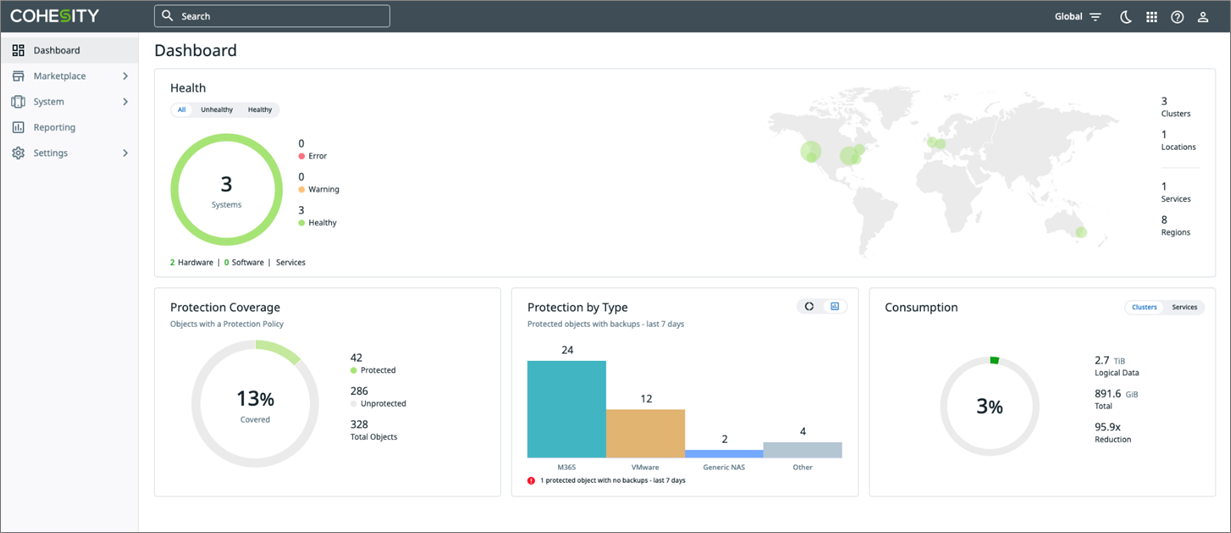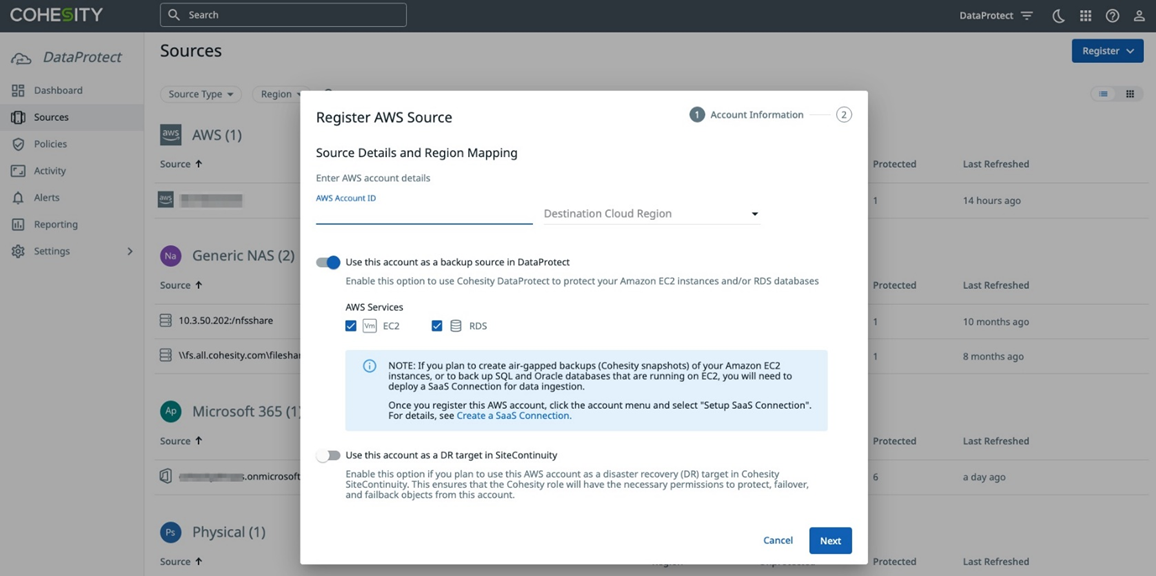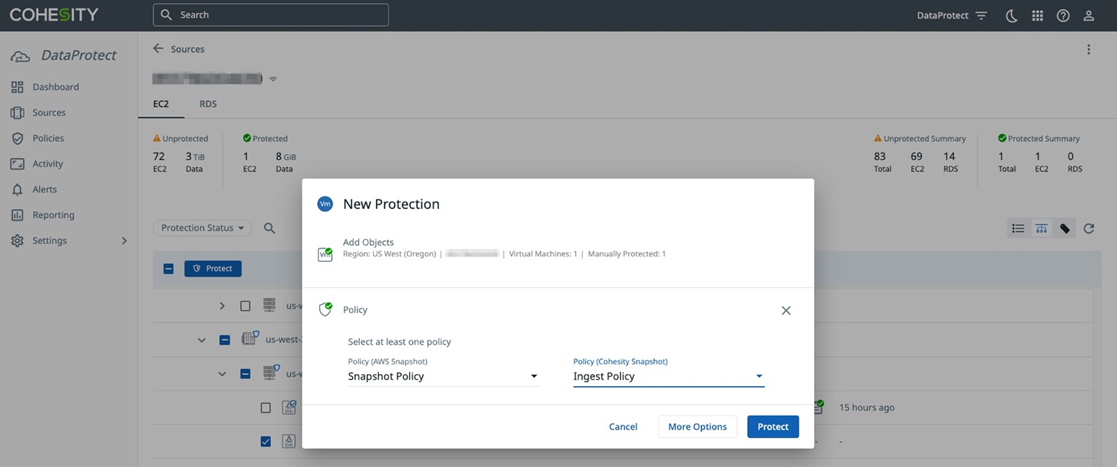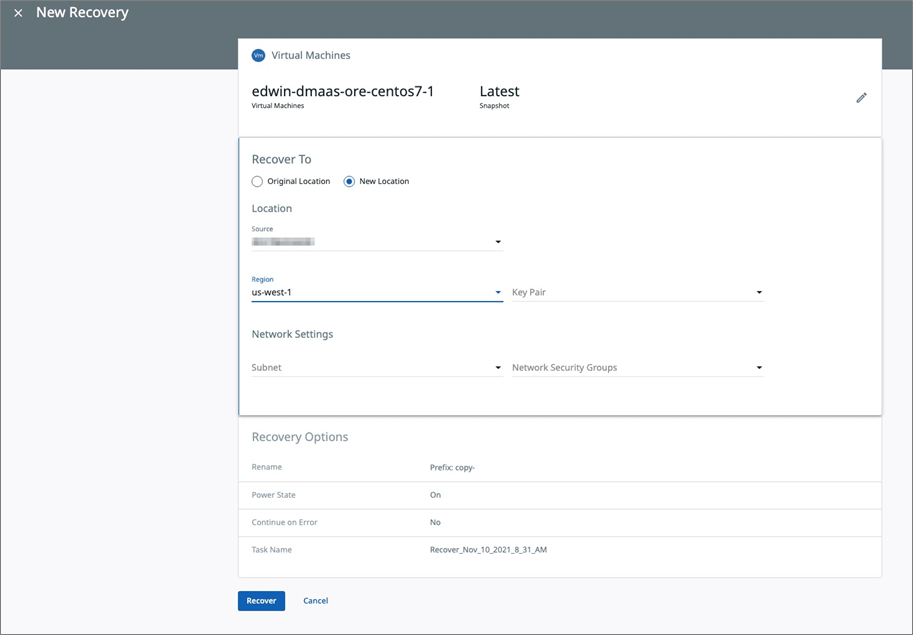AWS Partner Network (APN) Blog
Simplify Protection of AWS Workloads with Cohesity’s Data Management as a Service
By Girish Chanchlani, Sr. Partner Solutions Architect – AWS
By Edwin Galang, Cloud Solutions Architect – Cohesity
 |
| Cohesity |
 |
In today’s business environment, many enterprises adopt a hybrid cloud strategy with a wide variety of applications and data distributed across on-premises and the public cloud.
This includes applications like VMware, Network Attached Storage (NAS) filers, SQL, Oracle, SAP, and others running in on-premises data centers, and cloud workloads including Amazon Elastic Compute Cloud (Amazon EC2), Amazon Elastic Block Store (Amazon EBS), and Amazon Relational Database Service (Amazon RDS). Businesses also use software-as-a-service (SaaS) applications like Salesforce and Microsoft 365.
For protecting these virtualized, non-virtualized, and cloud-based applications, enterprises often use multiple point products. This approach has many challenges, including requiring specialized IT resources familiar with multiple products. It is also time-consuming and complex to manage, and can be expensive.
To meet this challenge of simplifying data protection for hybrid environments, Cohesity introduced Data Management as a Service (DMaaS), powered by AWS. Cohesity’s DMaaS portfolio encompasses multiple as-a-service offerings, including Backup-as-a-Service (BaaS) which is available in AWS Marketplace as Cohesity DataProtect. BaaS can protect a wide variety of cloud-based and on-premises applications.
As the DMaaS solution is provided as a service, customers do not need to deploy or manage any backup infrastructure or storage; all of that is provisioned behind the scenes in Cohesity’s AWS accounts. The service is presented via Cohesity’s globally available web interface, so for protecting workloads not running in AWS customers do not even need to have an AWS account.
In this post, we will walk through the process of configuring Cohesity DataProtect for protecting AWS workloads. This highlights the simplicity of using a single solution for protecting and managing your AWS workloads running in one or multiple AWS accounts, in addition to your non-AWS workloads.
Cohesity is an AWS Partner with the AWS Storage Competency that is redefining data management to lower total cost of ownership (TCO) while simplifying the way businesses manage and protect their data.
Configuring Cohesity DataProtect
Cohesity Helios is the centralized control plane that provides enterprises a single pane of glass for managing workloads protected by its BaaS service, DataProtect.
DataProtect supports on-premises workloads including VMware, NAS, SQL, physical servers running Windows and Linux, and cloud workloads such as Amazon EC2 instances and Amazon RDS, among others.
Figure 1 – Cohesity Helios dashboard.
From the Cohesity Helios dashboard, you can start using DataProtect to back up and recover workloads in your environment.
After signing in, the first step is to select the AWS region where you want your backup data to be stored.
Figure 2 – Cohesity DataProtect delivered as a service region configuration.
Once the region is selected, DataProtect will automatically provision a secure and encrypted environment for you to begin using the service.
Figure 3 – Cohesity DataProtect dashboard.
The next step is to register workloads you want to back up. For on-premises workloads, a lightweight agent called “SaaS connector” is deployed in your environment to transfer data over a secure and encrypted connection, between your on-premises environment and Cohesity DataProtect. It also provides client-side compression and deduplication to maximize the efficiency of this data transfer.
Protecting AWS Resources
For cloud-native workloads, Cohesity DataProtect will use the environment’s native APIs to back up and recover the data directly to and from the service. To register an AWS source to protect Amazon EC2 and Amazon RDS workloads, enter your AWS credentials in the Register AWS Source, as shown below.
Figure 4 – Registering an AWS source in Cohesity DataProtect.
Download the AWS CloudFormation template and execute in all AWS accounts that have resources that need to be protected. This template creates an AWS Identity and Access Management (IAM) role in your AWS account that grants Cohesity’s AWS account necessary permissions to access EC2 and RDS resources.
Make sure to verify the permissions granted to this IAM role are in-line with the security policies of your organization.
Once you have registered your sources, you can start backing up data to the Cohesity DataProtect service. To protect EC2 instances, select the instances you want to protect and then choose or create a backup policy that specifies backup frequency and retention duration for your instance backup data.
For EC2 instance data protection, you have the ability to protect with AWS snapshots and/or Cohesity Snapshots to meet your data protection requirements.
AWS snapshots use EBS snapshots to back up and recover EC2 instances. The data is stored in the customer’s AWS account.
Cohesity Snapshots create a backup of the EC2 instance and stores the data in DataProtect. This provides a more secure account separation, and allows for more flexible instance and data recovery with full and granular options and long-term retention. Note that for Amazon RDS, only AWS snapshots are supported.
Figure 5 – Protecting Amazon EC2 instances in Cohesity DataProtect.
To monitor activity in Cohesity DataProtect, the Activity Dashboard (see Figure 6) provides detailed information about tasks that are currently running and tasks that have completed in your DataProtect environment.
Figure 6 – Activity dashboard in Cohesity DataProtect.
To recover data in Cohesity DataProtect, select the object (virtual machine, instance, file share, databases) that you want to recover in the user interface (UI) and select the recovery type. With Cohesity DataProtect, you can recover full virtual machines, databases, EC2 instances, or perform granular recoveries of individual files and folders depending on your data recovery needs.
To restore EC2 instances, select the instance you want to recover and choose the recovery option. You have the option to restore EC2 instances to the same region, cross-region, or cross-account to a different AWS account.
To complete the restore process, specify the networking settings including subnets and security groups for the EC2 instances.
Figure 7 – Recovering Amazon EC2 instances in Cohesity DataProtect.
To perform granular recovery of a file or folder from an EC2 instance backup, select the instance and choose the file or folder (see Figure 8) that you want to restore. After selecting the file or folder, you have the option of either downloading the file directly from the UI to the local machine, or restoring the file to the original location or a new location.
Figure 8 – Granular recovery of files and folders in Cohesity DataProtect.
The method is similar for protecting Amazon RDS and other on-premises and cloud-based workloads, providing the simplicity of managing your hybrid environment via a single solution.
Conclusion
In this post, we introduced Cohesity’s Data Management as a Service (DMaaS) portfolio and walked through the process of configuring and using DataProtect for protecting AWS workloads.
From a single management interface, you protect and manage AWS workloads running in multiple AWS accounts, while also protecting SaaS and on-premises applications as well. This offers customers a simple but powerful solution for managing hybrid workloads.
For more information on DataProtect, including a free 30-day trial, visit cohesity.com or sign-up directly on AWS Marketplace.
Cohesity – AWS Partner Spotlight
Cohesity is an AWS Storage Competency Partner that is redefining data management to lower TCO while simplifying the way businesses manage and protect their data.
Contact Cohesity | Partner Overview | AWS Marketplace
*Already worked with Cohesity? Rate the Partner
*To review an AWS Partner, you must be a customer that has worked with them directly on a project.








